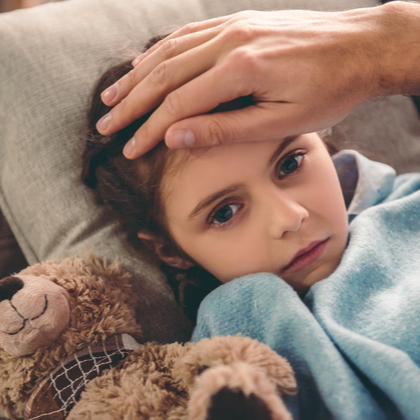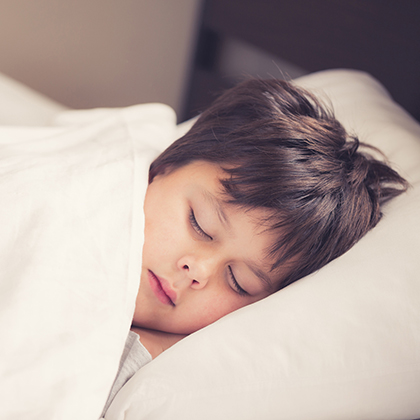
If your child seems to be catching every bug that’s going around, it may be distressing but it’s also normal. After all, children are particularly prone to getting sick when they’re young because their bodies are still building immunity to all those germs they encounter regularly in the school playground.
As a parent, it’s natural for you to want to stop your child ever getting sick. But not only is that very difficult – perhaps even impossible – to achieve, it’s also not advisable. That’s because being exposed to a variety of bugs will make your child’s immune system stronger, which can help them resist a range of illnesses as they get older.
It’s thought most children will catch at least one or more infectious illnesses at some stage – for instance, according to the National Institute for Health and Care Excellence (NICE), children experience an average of five to eight colds every year (compared with two to three colds a year in adults) (i).
Routine vaccines are available to protect children against more serious diseases. Many important childhood vaccines are available free on the NHS, with the first ones given when a baby is just two months old (or even earlier, as pregnant women can protect their unborn baby against whopping cough by getting a vaccine, typically when they are 28 - 32 weeks pregnant).
The MMR vaccine, for instance, protects against measles, mumps and rubella (German measles). It’s usually given in two doses, the first when a child is around 13 months old and the second when they are three years and four months old.
Besides making sure your child receives their vaccinations at the right times, you may want to be aware of the signs and symptoms of common childhood infections. It’s also a good idea to arm yourself with information on what you can do to make your little one feel better when they do bring a bug home from school.
How do infections spread in children?
Bugs that cause illness – or pathogens, to give them their scientific name – can spread easily in schools and nurseries because these are places where children play in close contact with one another. If one child is infected with a bug they can infect others through the air when they cough or sneeze. Infections can also be transmitted by objects or surfaces that an infected child has touched, coughed or sneezed over – if your child touches one of these objects or surfaces and then puts their hand on their mouth, nose or eyes, they can then become infected with the same bug.
This is why health experts recommend that parents teach their children good hygiene practices – including keeping their hands as clean as possible – early on, especially before they start nursery, day care or school. Other helpful hygiene practices you can pass on to your child include coughing or sneezing into their elbow, not sharing cups or cutlery and throwing used tissues into the bin immediately after use.
When should you take your child to a doctor?
While many common childhood infections can be treated easily at home, it’s important to get professional medical advice if you’re concerned in any way about your child. Also take them to see their GP if your child doesn’t start to improve after a day or two of being looked after at home, if their symptoms are getting worse, or if any of the following apply:
-
They have pain that doesn’t get better after taking children’s paracetamol or ibuprofen.
-
They have a high temperature that doesn’t improve within five days (see our guide to Children’s health: fever or high temperature for more essential details).
-
They’re having persistent vomiting and/or diarrhoea (that is, they have vomited three or more times or have had diarrhoea six or more times in 24 hours).
-
They refuse to drink anything or can’t keep liquids down.
-
They’re producing fewer than half their usual number of wet nappies.
-
They are aged three months or younger and have a fever or aren’t feeding as well as usual.
Take them to see their doctor straight away or call for an ambulance if…
-
They are having breathing difficulties.
-
They look very pale and are hard to wake.
-
They have a rash combined with a headache, stiff neck or back pain.
-
They have a rash or spots that don’t disappear when you place the side of a clear glass against them (read our guide to Septicaemia and meningitis in children to find out more details about the danger signs to look out for).
Rashes and itchy skin
Chickenpox
What is chickenpox?
Caused by the varicella-zoster virus, chickenpox spreads easily, including among children. It causes an itchy red rash made from spots that become fluid-filled blisters, which can burst and form into scabs. Children with chickenpox can also have a high temperature and feel generally unwell, with aches, pains and loss of appetite.
Most importantly, if your child has chickenpox you should keep them at home until they are no longer infectious (that is, when all their spots have turned into scabs).
What is the most effective treatment for chickenpox?
-
Make sure your child gets plenty of rest until they’re feeling better.
-
Give them plenty of fluids to drink to avoid dehydration.
-
You can give them paracetamol for aches and pains, but avoid giving them ibuprofen, as it can cause complications in cases of chickenpox.
-
Bathe your child in cool water to help soothe any itching. You can also apply over-the-counter products such as cooling skin gels, creams or lotions (such as calamine lotion) to ease irritated skin.
-
Try to distract your child when they’re trying to scratch to minimise the risk of scarring. If necessary, keep their nails short too.
Measles
What is measles?
Like chickenpox, measles is highly infectious and can be quite unpleasant. In a few cases it can also lead to serious complications reddish-brown blotchy rash, but before this appears your child may feel unwell with a high temperature, runny nose, cough, sneezing, sore eyes and small whitish spots inside their mouth.
If you suspect your child has measles it’s important to call their GP as soon as possible (don’t take them to the surgery as they could infect others).
How can you treat measles at home?
-
Make sure your child rests up and has plenty of drinks (warm drinks will also help ease a cough).
-
Keep them in a darker room if their eyes are sensitive to light. If their eyes are sore, clean them gently using a cotton wool pad soaked in water that has boiled and cooled.
-
If they have pain or a high temperature you can give them paracetamol or ibuprofen.
German measles
What does German measles look like?
There aren’t many cases of German measles – or rubella – these days, thanks to the NHS vaccination programme. If a child does get German measles their symptoms are usually mild, but it can cause serious problems if they pass the infection to a pregnant woman. I your child does go down with German measles (or even suspected German measles), it’s important to keep them away from other people, especially women who may be in the early stages of pregnancy or who are trying to get pregnant.
Your child may have German measles if they have a red or pink spotty rash as well as other symptoms such as a fever, sneezing, runny nose, coughing, sore throat, swollen glands, sore eyes, headache and joint aches (though joint pain is more common in adults than in children). The symptoms usually last for a week to 10 days.
What is the best treatment for measles in children?
-
Make your child get plenty of rest and give them lots of fluids.
-
You can also give them paracetamol or ibuprofen if they have a high temperature or if they have aches and pains.
-
Applying a cool – but not cold – compress to their forehead can also feel soothing if they have a fever.
Find out more about these and other skin infections in children by reading our guide Skin Conditions in Children: How to Soothe Your Child’s Skin.
What is the difference between measles and German measles?
-
Measles and German measles may sound similar but they are caused by two completely different viruses:
-
Measles is caused by a virus that infects the respiratory system. It first shows as small white spots in your child’s mouth, followed by a red rash on their body.
-
German measles is caused by a virus that invades the lymph notes, eyes and skin. There are no white spots in the mouth but the virus causes a red or pink rash that often starts on the face and moves to the body.
Of the two, measles causes the most severe symptoms, with German measles symptoms being generally milder (though it can cause very serious problems in pregnant women).
Natural support for children's immunity
You may not be able to stop your child going down with a bug, but there are things you can do to support their immune system while they’re sick and to help keep their immunity strong when they’re well.
Good nutrition is important for keeping your child as healthy as possible, which means keeping their immune system healthy too. So try to make sure they get at least five portions of fruit and vegetables every day, as this means their body will be getting a good range of nutrients.
You may also want to consider giving them a multivitamin and mineral supplement – especially if they are a fussy eater. Choose a good-quality supplement designed for children that will give them all the important vitamins and minerals their immune system needs. If they don’t like swallowing tablets there are other options, such as effervescent multivitamin and mineral tablets that dissolve in water to make a pleasant-tasting drink, as well as tasty chewable multivitamin and mineral tablets (look for one that’s kind to their teeth).
Not sure what to choose? Take a look at our guide to Multivitamins for children to help you decide.
High-strength fish oils You may also want to consider giving your child a fish oil supplement, since the omega-3 fatty acids found in oily fish such as salmon, herring, mackerel and sardines are widely thought to be helpful for children’s general health (plus they’re ideal for kids who don’t like the taste of fish). Fish oil supplements often tend to be quite large, so look for one that comes in a small capsule size that a child can swallow easily.
Elderberry Grown on the Sambucus tree, elderberries have a long traditional use for the relief of common infections including colds and flu. Look for a good-quality, naturally sweetened elderberry liquid that your child will love to take straight off the spoon.
Vitamin C This is an important vitamin that’s needed for many body processes. Experts also believe that not getting enough vitamin C may weaken a child’s immune system (ii). You can find vitamin C in multivitamin and mineral supplements, but it’s also available as a single supplement.
Zinc We all need zinc for a healthy immune system, but many of us – including children – may not be getting enough of it in our diets. Foods that contain good levels of zinc include meat, shellfish, legumes, nuts, seeds, dairy foods, eggs and whole grains. If your child doesn’t eat many zinc-rich foods, a supplement may be the answer. Most good-quality multivitamin and mineral supplements will contain a decent level of zinc, but you could also try giving them zinc lozenges (these not only taste nice but you can get them with added vitamin C too).
Vitamin D Children need to get the right amount of vitamin D for their immune systems to function normally. These days, the government recommends that all children from birth to four years old take a daily vitamin D supplement throughout the year, while those who are four years and older should take it during the autumn and winter months (though there’s a good argument for giving children of any age vitamin D supplements all year round if they don’t spend much time outdoors in the spring and summer months or if they usually wear clothes that cover up most of their skin when they’re outdoors).
Again, you can give your child the vitamin D they need in a good multivitamin supplement. Alternatively there are vitamin D supplements available – and if your child doesn’t like taking tablets, you can give them vitamin D drops.
It’s never easy for parents when their children are sick, but having common mild infections is normal and it even makes their immunity stronger and healthier. Knowing the difference between a mild infection you can treat at home and something that may be more serious is essential for all parents – plus it can also be helpful to know how to soothe their symptoms when you’re looking after them. There’s lots more information on children’s and adults’ health conditions in our pharmacy health library – why not take a look around?
References:
(i) Available online: https://cks.nice.org.uk/topics/common-cold/background-information/prevalence/
(ii) Maggini S, Wenzlaff S, Hornig S. Essential role of vitamin C and zinc in child immunity and health. J Int Med Res. Mar-Apr 2010;38(2):386-414. Available online: https://journals.sagepub.com/doi/10.1177/147323001003800203
Related Posts
Disclaimer: The information presented by Nature's Best is for informational purposes only. It is based on scientific studies (human, animal, or in vitro), clinical experience, or traditional usage as cited in each article. The results reported may not necessarily occur in all individuals. Self-treatment is not recommended for life-threatening conditions that require medical treatment under a doctor's care. For many of the conditions discussed, treatment with prescription or over the counter medication is also available. Consult your doctor, practitioner, and/or pharmacist for any health problem and before using any supplements or before making any changes in prescribed medications.

Christine
Christine Morgan has been a freelance health and wellbeing journalist for almost 20 years, having written for numerous publications including the Daily Mirror, S Magazine, Top Sante, Healthy, Woman & Home, Zest, Allergy, Healthy Times and Pregnancy & Birth; she has also edited several titles such as Women’ Health, Shine’s Real Health & Beauty and All About Health.
View More



